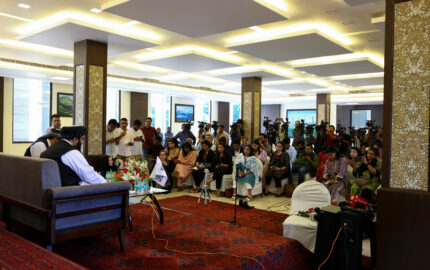Sudan’s ongoing war has upended the country’s nascent and burgeoning digital media scene and created a chaotic, polarized information space. The Sudanese journalists who continue to report on the conflict, including the recent wave of killings in El Fasher, risk the most extreme consequences. The Committee to Protect Journalists has documented the killing of at least 14 journalists and media workers in Sudan since the conflict began in 2023, and hundreds more have been attacked, arrested, and forced to flee.
A new report prepared by academic researcher Aida Al-Kaisy for Internews Europe, with assistance from the Sudanese multilingual digital multimedia and research platform Andariya, describes how Sudan’s war has created a new wave of information warfare, where the warring parties attack journalists and create their own propaganda, using social media to divide citizens.
- The conflict has triggered mass displacement of media professionals. Print newspapers vanished almost overnight as their Khartoum headquarters became inaccessible, while most television and radio stations were either closed, demolished, or transformed into propaganda tools. The majority of experienced journalists have been displaced or forced into exile across neighboring African countries, the Persian Gulf, Europe, and beyond. This collapse has created a severe skills gap in who can produce professional content.
- Sudan’s media landscape has turned into a “parallel battlefield,” with information warfare operating alongside the physical conflict. As journalists have fled, we have seen new sorts of content being produced by people outside professional norms and regulatory frameworks. Both the Sudanese Armed Forces and Rapid Support Forces, the major antagonists in the war, play a role in enabling this situation. The role of the United Arab Emirates in the manipulation of information in Sudan must also not be underestimated. Both warring parties have weaponized media as part of their conflict strategy, viewing independent journalism as fundamentally threatening to their narrative. Journalists have been killed, systematically harassed, and arbitrarily detained. Forced narrative alignment has become commonplace.
- Sudanese women journalists endure a higher danger of attack. The targeting of women is often deliberate and premeditated, and gender-based violence is used as a specific weapon against women in media.
- Human rights monitors and reporters, including those supported by Internews, have been singled out by both warring parties. These individuals face harassment, intimidation, and violence as they work to document abuses and provide accurate information, highlighting the growing risks for those committed to defending press freedom and human rights in conflict zones.
- Citizens are not getting the information they need. This conflict has been marked by a deliberate targeting of hospitals, schools and essential services, and as the media are unable to function, people cannot access the essential, immediate information they must have to survive.
- In the absence of reliable traditional media, Sudanese citizens have turned overwhelmingly to social media platforms — particularly Facebook, WhatsApp, and TikTok — as primary information sources. This shift has intersected with systematic information manipulation and disinformation campaigns alongside the emergence of unregulated "citizen journalists" who often lack professional training but can wield significant influence. The result is an information environment characterised by alternative facts, misleading narratives, and hate speech, all of which continue to further entrench divisions and conflict.
- Video manipulation and artificial intelligence have become weapons in this war, with deepfakes of key political figures sowing discord and confusion. Even in cases like the El Fasher massacre, fake images are spread when horrifying, genuine photos already exist.
- The collapse of state institutions means traditional regulatory frameworks and legal protections no longer exist. At the same time, all of society is militarized, with no acceptance of the concept of journalistic impartiality. The war itself is sustained by information manipulation, including false promises of quick victory.
- Groups that are already marginalized — women, displaced persons, people with disabilities, and rural populations — have been hardest hit. They are systematically excluded from vital information they need to survive. Internet connectivity remains poor or entirely absent in many areas, while those with access can often receive only content controlled by military entities. This digital divide has created information bubbles that reinforce geographic and social fragmentation. Community radio stations play a role in providing localized information in some regions, although they also struggle with connectivity and limited resources.
- There is still innovation out there. Journalists operating in exile have created new outlets and platforms that can counter hate speech while maintaining professional standards. However, these initiatives face significant sustainability challenges, operating largely through international donor support and volunteer efforts while lacking the resources and protection mechanisms necessary for long-term viability.
Journalists and those who support journalism must stand in solidarity with Sudanese journalists right now. They need support to relocate to safe spaces, and they need digital security, legal support, and to be part of professional networks in their new communities, whether they are inside Sudan or outside.
The new storytellers filling the information gaps created by the collapse of the media sector in Sudan also need support to maintain editorial standards and do effective conflict reporting and verification. They must understand their audience's needs and perspectives.
In the future, Sudan will have to rebuild its regulatory and legal environment for the media. Networks like the Sudanese Journalists Syndicate and the Sudan Media Forum can provide a useful starting point for discussions over what will be needed to make Sudan’s media viable and relevant again. Sudan’s war comes as donors worldwide are cutting budgets and withdrawing from global development, but independent journalism will be critical for civilian survival, accountability, and eventual democratic transition. Given Sudan’s substantial influence across the region, this cannot be avoided. Independent media needs funding, and strategies must include efficiency-maximizing solutions, innovative funding strategies, and a focus on sustainability.
You can read the “2025 Sudanese Media Ecosystem Report” in full here.
Meera Selva is the CEO of Internews Europe, a media support nonprofit working in more than 50 countries.



